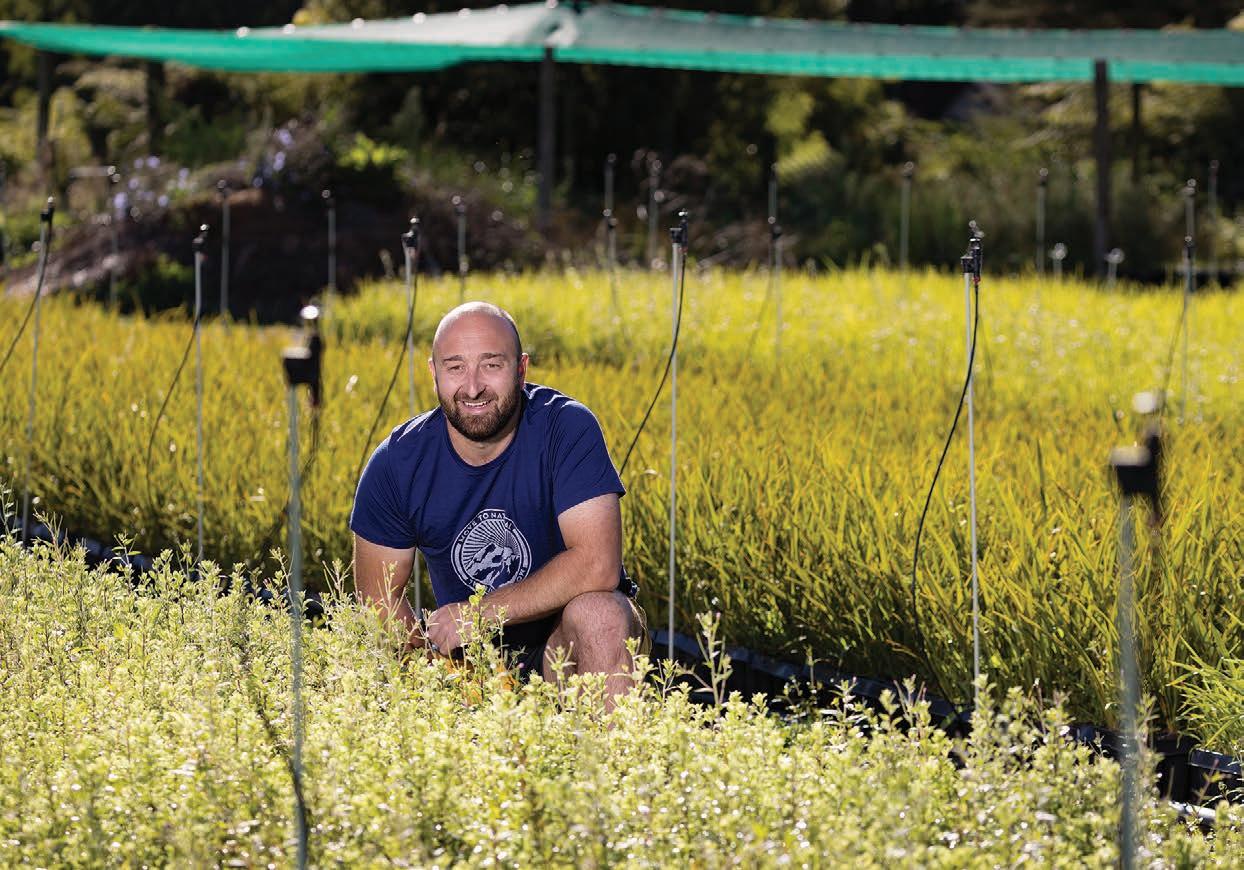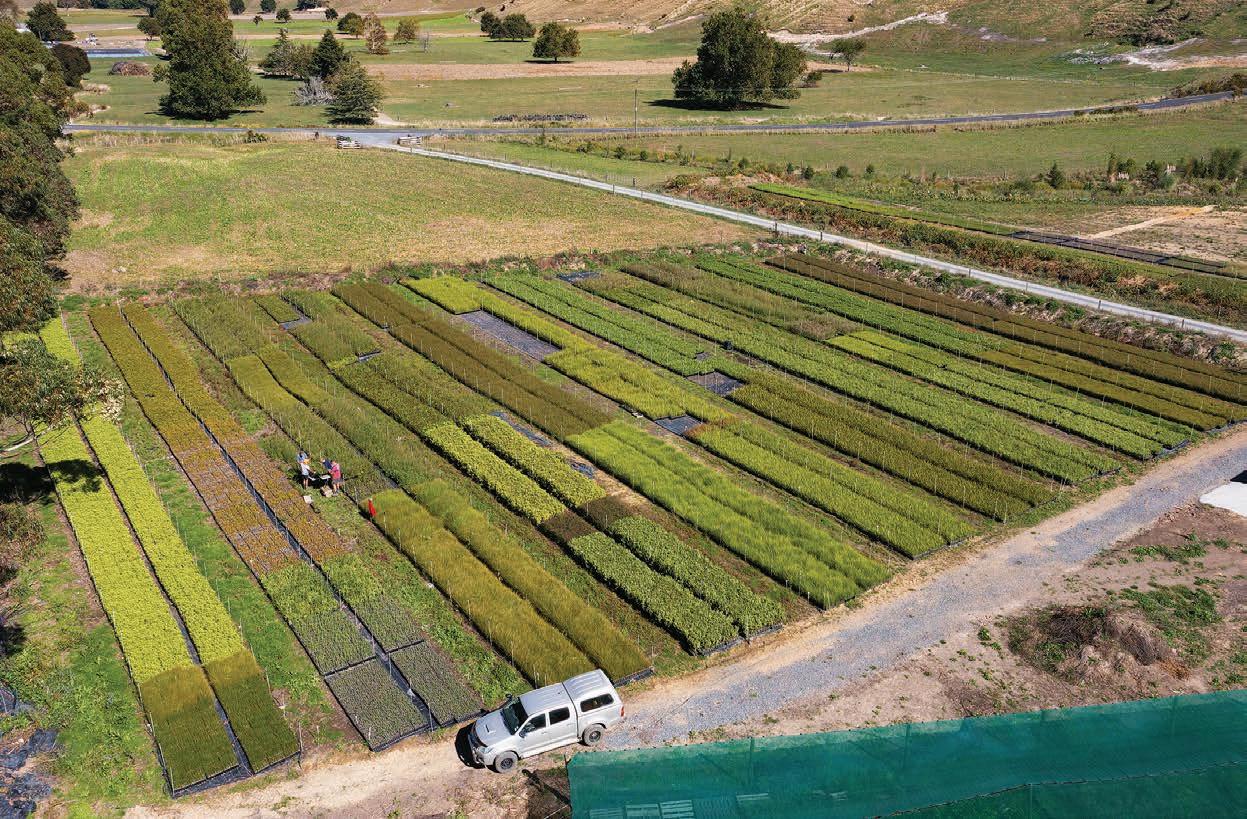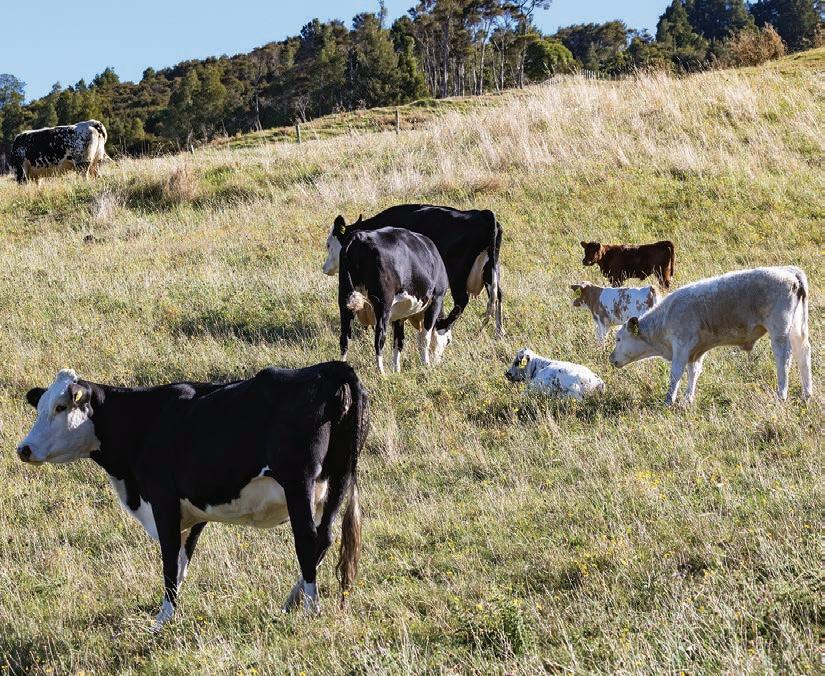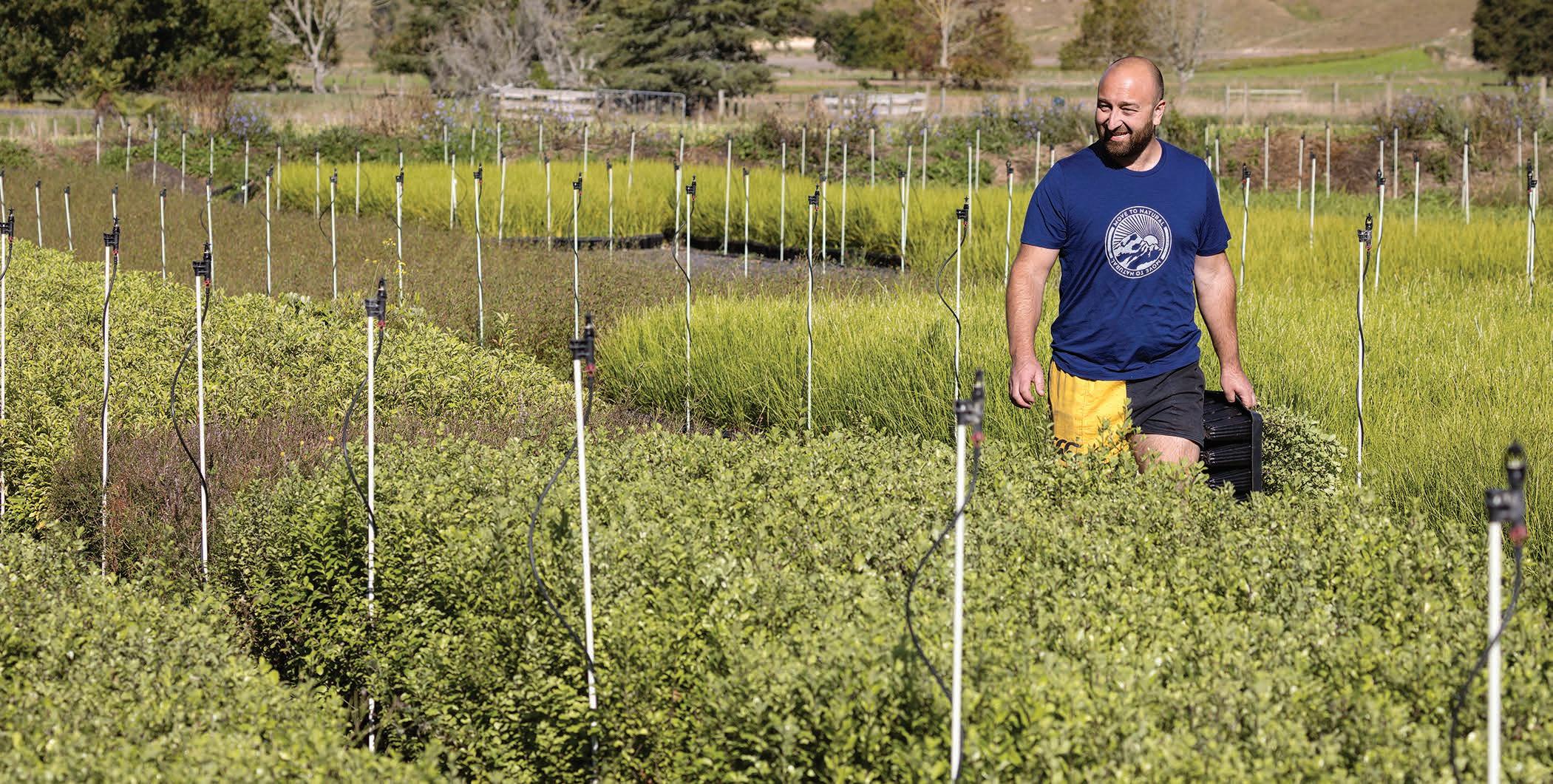
9 minute read
On Farm Story
28 FARMERS WEEKLY – farmersweekly.co.nz – April 4, 2022
On Farm Story Nursing native forests
A Cambridge farmer built his nursery business model around lowering the barriers for farmers to plant more trees. He spoke to Gerald Piddock.
FOR Adam Thompson, establishing native flora on farmland goes beyond the obvious environmental and biodiversity benefits.
It gives farmers a sense of pride in seeing a piece of marginal, unproductive land transformed into something that complements and enhances their farming operation.
“A lot of farmers are proud of growing food. We’re helping them do it in a more sustainable way,” Thompson said.
The 35-year-old Cambridge farmer and owner of Restore Native tree nursery wants all farmers to feel that pride by making it as easy and inexpensive as possible to plant and grow native trees on farmland not suited for livestock.
The nursery specialises in all native trees and all firstgeneration colonisers like mānuka, kānuka, cabbage trees and flaxes.
These species create a canopy, creating favourable growing conditions for larger tree species such as kahikatea and rimu to then get established.
It also gives farmers a better connection with consumers particularly as social media breaks down barriers between them and customers.
“It makes you happier going to work every day,” he said.
“You see the mana of that land come back with the trees and then the birds come back and they bring more seeds that create a forest.”
Thompson said he built the nursery business model around lowering the barriers for farmers to plant more trees.
These barriers could be financial, being time-poor, or lacking the knowledge of what species to plant to reflect the type of work the farmer needs.
Tree survival is also a barrier, particularly in its first year of growth and Thompson and his staff offer a maintenance service to ensure its survival in that early stage.
He also supplies plants for riparian development, which has helped with on-farm wetland development and employs a planting crew of eight to assist landowners with getting the trees in the ground.
“There’s been some really cool projects. When you see farmers – especially older farmers – who have grazed cattle to the edge of a waterway all of their lives and now they are fencing it and planting,” he said.
“You do it for two or three years and you go back and see it and it’s just awesome.”
Thompson grew up on a farm in Matamata, Waikato. He left school and worked as a fencer for an agricultural contractor and remained committed to the outdoors and bush areas through hiking and hunting.
He then started chasing money to save and purchase farmland in his 20s when he accepted an internship as a mortgage broker for residential property.
That eventually led to him starting his own business, My Mortgage, which employs 12 people and has been operating just over 10 years.
These days, he works 5-10 hours a week at the mortgage business, mostly as an advisor, as he looks to dedicate more time to the nursery and his farm.
His passion for native trees came from his wish to see more birds and other wildlife in the forest.
“I started planting trees in the lifestyle block I had when I was young. I learned more and more about the relationship between the birds and the trees and the land and how it’s symbiotic,” he said.
He started planting trees when he was 20 and kept at it over the years as he brought, improved and then sold lifestyle land at Tirau and Maungakawa, before purchasing a 200-hectare farm near Cambridge in 2018.
The cost of buying trees saw him begin to grow his own to finance his passion.
“It never started out as a business and I probably spent the best part of 10 years growing trees for myself,” he said.
Thompson learned to grow the trees by trial and error and by 2019 he was growing around 20,000 tree saplings in a makeshift nursery and he started approaching friends and neighbours to see if they were interested in buying his surplus plants.
In that same year, he completed the purchase of the farm.
Then the covid-19 lockdown hit the country.
“I thought there was no future in mortgage broking and property will tank – I was wrong,” he said.
He upscaled the nursery to grow 250,000 plants and decided to focus on it because that was where his passion was and formally established Restore Native.
Since then, it has expanded further to 500,000 trees, employing five staff and a farm manager. By 2023, he hopes to have over one million trees for farmers to purchase.
He also stepped back from his role as a mortgage adviser for family reasons. It allows him opportunities to spend more time on the farm and the nursery with his two young children.
Working with trees and bush has also fuelled his interest in predator control and Thompson is a trustee of Predator Free Cambridge.
Once a month, his staff do predator control work in the district to reduce damage from possums and rats.
Thompson said the nursery is not driven by profit but by seeing positive change in farming.
If it was purely about making
Adam Thompson Farmer
GROWING BUSINESS: Adam Thompson at te Miro, near Cambridge. His passion for native trees came from his wish to see more birds and other wildlife in the forest, which led him to start Restore Native nursery. Photos: Stephen Barker


money, he said he would have stayed as a mortgage broker.
“I’m growing trees because I want to and it’s why the business is called Restore Native. We are there to do more than just plant trees. We’re there to restore those areas back to their potential and I want to help farmers do that,” he said.
He generally sees two kinds of people who inquire about planting: young farmers committed to doing better for the environment and those coming to the end of their farming careers who want to ‘make things right’ after engaging in environmentally destructive farming practices earlier in their lives because they did not know any better.
“It’s fascinating seeing that changing attitude of farmers,” he said.
That change can’t be driven from an office or from central government. Farmers need to see it from people with callouses on their hands, he says.
“Those are the people they trust,” he said.
His efforts were rewarded earlier this year when he was named as a Zanda McDonald finalist for New Zealand. The award recognises young people working in the primary industry sectors in NZ and Australia and supports their future career development.
Being nominated as a finalist was a fantastic experience, despite the challenges caused by the covid-19 restrictions around gatherings, he said.
“It gives you that extra sense of belief that you’re on the right track and doing the right thing,” he said.
The busiest time of the year for the nursery is about to start with orders lined up for his staff to put in 110,000 plants in the ground on farms around the region. An almost equal number of plants have also been ordered by farmers to be collected and planted themselves.
“We’ll wind up planting another 200,000 of our own and sell out the remaining 300,000,” he said.
The busy peak in the nursery synchronises well with his farming calendar.
The farm is a mix of rolling to steep hills, with 150ha of it being effective. The rest is in two blocks of native bush. It also contains a lot of small pockets of marginally productive land. Included in the effective land is a separate 12ha block used to grow his in-calf heifers.
The farm runs dairy-beef breeding cows mated with Charolais and Speckle Park genetics, with calving starting on March 1, wintering 375 cows, yearlings and calves.
He farms this way for several reasons. He calves in autumn so he can concentrate on planting during spring and it also means avoiding the stress that comes with the challenge of trying to chase weight gain on the animals over the summer.
He can also spread out the animals over winter, preventing pugging damage. It also balances out staff labour, with the six staff he employs splitting their time between the farm and the nursery.
Calving finishes at the end of April and from there, it’s straight into planting through to the end of September.
“Just as planting is starting to taper off in the spring in September, the farm stuff starts to ramp up,” he said.
Summer feed crops are then planted and the calves are weaned in November. This year he is targeting a 260kg weaning weight.
Half are sold as store and the rest are farmed through and sold to the processors as rising twoyear-olds.
The system also allows him to sell the cattle at a schedule peak, ensuring he gets a top price at the works.
Over the next few years, he plans to keep developing and expanding the nursery.
“I want to be able to do more for farmers. We’re up against some headwinds with all of that farm environmental stuff and I want to be a key person in the toolbox for helping those farmers to find those solutions,” he said.
His farming background and experience of growing trees means he thinks he is well-placed to be able to provide that service.
“We’ll do a million trees in the nursery next year and we should double that the following year to do two million and we should double that again the following year to four million. That’s my three-year-plan,” he said.
To fuel that growth, he has just invested in $750,000 of new nursery infrastructure.
“It’s the thing I’m most passionate about. I love getting out on the hills with the kids and chasing cows around,” he said.
“The opportunity I see in the nursery and the passion I have for trees and being part of the solution for farmers is really exciting.”
BALANCE: Thompson works 5-10 hours a week at his mortgage business, mostly as an advisor, as he looks to dedicate more time to the nursery and his farm.

Adam Thompson Farmer
>> Video link: bit.ly/OFSthompson
HARD YARDS: Thompson learned to grow the trees by trial and error and by 2019 he was growing around 20,000 tree saplings in a makeshift nursery.







